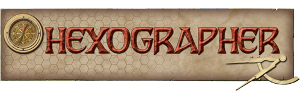Quick Start
- Set the size of the map by choosing the number of hexes wide and number of hexes high.
- Optionally, choose settings for the hex width and hex height. (You are also able to change these settings as you view/edit the map later.)
- Choose the terrain type: “Normal Terrain” will result in a little over half water. “Many Islands” will create a map that is mostly water and “Few Oceans” creates a map that is mostly land. “Custom Terrain” pops up a matrix that you can use to alter the probabilities of each terrain. “Blank Terrain” will create a map of white hexes. It is a little complicated, but basically it allows you to control how likely one hex will be a particular terrain based on the terrain types around that hex.
- Click “Generate Map” to see your map.
- Customize it by clicking a terrain button on the right side of the map then clicking hexes on the map where you desire that terrain type. (You can also drag over terrain to change a bunch of terrain to the selected type or you can right click a hex on the map to pop up a menu.)
- Click the “Lines” or “Text” tabs on the left edge to add lines and text to the map. Note: there is some help text at the very bottom of the map editing window. Each of these tabs reveals two sub-tabs: “Styled Lines” and “Custom Lines” (in the case of lines) and “Styled Text” and “Custom Text” (in the case of text.)
- The “Styled Lines” and “Styled Text” tabs list several types of lines and text so you can keep your rivers, roads, borders, etc. consistent. (The same color, size, etc.) Also, you can customize these by going to the “Options” menu and choosing “Customize Line/Text Settings.” Changing a setting will change that aspect of all matching lines or text.
- The “Custom Lines” and “Custom Text” tabs allow you to specify the line or text properties for one specific line or text and add it to the map.
- Choose “File” then “Save” to save the map in the Hexographer’s native format. Choose “File” then “Export” to save the map as a PNG image.
